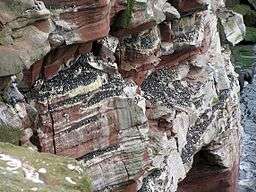St Bees Head
Coordinates: 54°30′14″N 3°37′56″W / 54.50398°N 3.63229°W

St Bees Head is a headland on the North West coast of the English county of Cumbria and is named after the nearby village of St Bees.
It is the only stretch of Heritage Coast on the English coastline between the Welsh and Scottish borders, and is a Site of Special Scientific Interest. The sea off the Head is protected as part of the Cumbria Coast Marine Conservation Zone. It lies on two long-distance footpaths, the Cumbria Coastal Way and Wainwright Coast to Coast. Both long-distance footpaths follow the edge of the cliffs, which rise to 90 metres above sea level,[1] and afford spectacular views of the Cumbrian mountains and coast.
North Head
The true geographical head is the North Head, which is the most westerly point of Northern England and is the site of St Bees Lighthouse. During WW2 a radar station was operated from here, and some of the buildings can still be seen adjacent to the lighthouse. The foghorn building is to the west of the lighthouse, but is now disused. The lighthouse is still operating, but is unmanned. Next to the coastal path north of the lighthouse is Birkhams quarry which is still in use for extracting St Bees sandstone. The rocks on the sea platform at the North Head are now a very popular bouldering area for climbers and there are a number of bolted climbing routes on the cliff itself.
Bird reserve

The RSPB maintains a reserve, which includes kittiwakes, fulmars, guillemots, razorbills, cormorants, puffins, shags and herring gulls. It is the only breeding place in England for black guillemots. Several other birds are known to use this site regularly for breeding and these include the tawny owl, sparrowhawk, peregrine, raven and the rock pipit, which is known to breed in only one other site in Cumbria. There are observation stations on the North Head footpath.
South Head
The South Head is known locally as "Tomlin" and dominates the long sandy St Bees Beach. At the top of the footpath from St Bees are the remains of the coastguard lookout. This now has a viewing table in its ruins.
Fleswick Bay
Between the two headlands is Fleswick Bay. This is accessible only on foot or from the sea, and is a spectacular location consisting of a shingle beach on a wave cut platform bounded by high sandstone cliffs. The coast to coast walk descends to the bay en route to the North Head.
Flora
The rugged cliff face supports diverse flora mainly due to the nature of the rock formations. Species found lower down are: sea pink - Thrift armeria maritima, scurvygrass - Cochlaria officinalis, sea campion - Silene maritima, sea spleenwort - Asplenium marinum, rock samphire - Crithmum maritimum and the rare rock sea lavender - Limonium binervosum. Near the cliff top is bloody cranesbill - Geranium sanguineum, Wood vetch - Viccia sylvatica, Orpine - Sedum telephium and soft shield-fern - Polystichum setiferum. Along the cliff top, there can be found Dyer’s greenweed - Genista tinctoria, western gorse - Ulex gallii, heather - Calluna vulgaris and bracken - Pteridium aquilinum.
Physical features
The cliffs are composed of a red Permian and Triassic sandstone about 200 Million years old. St Bees sandstone was created by water borne sand and has a very small grain size, making it a very workable stone still much in demand for building. The mica in the stone gives it a sparkling effect. St Bees sandstone occurs as far north as Brampton, but it is named after its most prominent outcrop here at St Bees.
The SSSI citation [1] carries a description of the interesting geological features. On the headland itself is evidence of erosional features, wave cut notch and a wave-cut platform. On St Bees Beach to the south to lessen the effects of longshore drift, a row of nine groynes have been put in place.
Further south, St Bees Beach is backed by small mud cliffs which are an excellent place to study the glacial moraines that formed them. The shingle both at St Bees and Fleswick bay show a huge variety of glacier-borne stones.
Gallery
 The North Head and Fleswick Bay seen from the St Bees path
The North Head and Fleswick Bay seen from the St Bees path- Fleswick Bay, looking south
 The north end of Fleswick Bay
The north end of Fleswick Bay The Isle of Man seen from Fleswick Bay
The Isle of Man seen from Fleswick Bay- Wave cut platform at Fleswick Bay
- A cave at Fleswick Bay
 Sandstone cliff formation at Fleswick Bay
Sandstone cliff formation at Fleswick Bay The South Head from St Bees beach.
The South Head from St Bees beach. Panorama to the fells from the South head.
Panorama to the fells from the South head.
References
- 1 2 SSSI citation for St Bees Head. Date of Last Revision: 1995
- Lakeland Rocks and Landscape, a Field Guide. The Cumberland Geological Society. Pages 62–68, The Permo-Trias of St Bees Headland, by Tom Shipp. ISBN 1-873551-03-7
- The Lakes - Rock Fax 04. Vertical Brain Publications. ISBN 1-873341-15-6 (Climbing guide)
External links
| Wikimedia Commons has media related to St Bees Head. |
- Guide for visitors
- RSPB reserve
- St Bees village web site
- SSSI citation for St Bees Head
- The Cumbria Directory - St. Bees Head Heritage Coast